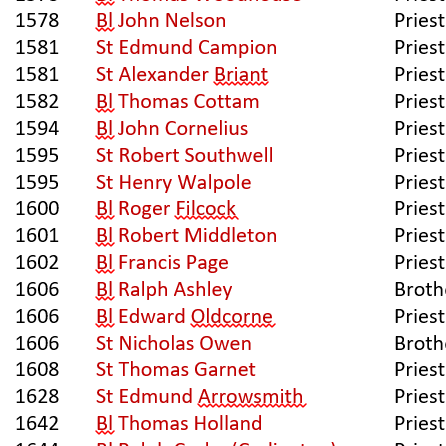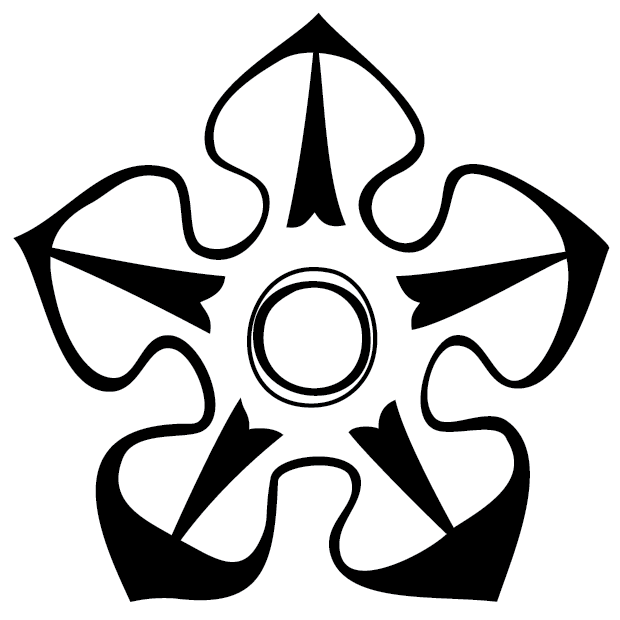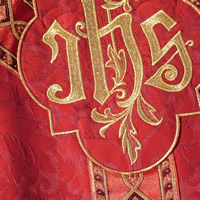| Resources St Edmund Campion SJ |
 |
| Campion Day |
St Edmund Campion SJ was martyred on 1st December 1581. 1st December is the day on which his Feast is celebrated in the British Province of the Society of Jesus. St Edmund Campion is regarded as patron of the British Jesuit Province and his feast day is marked in Jesuit communities, parishes and schools. On 1st December we celebrate the ten saints and eighteen beati, martyrs of the British Province. In the calendar of the English Church, St Edmund Campion is remembered on 4th May along with all the men and women martyred for the Catholic faith in England between 1535 and 1680.
|
| The Life of St Edmund Campion SJ |
Edmund Campion was born in 1540, the son of a bookseller in Paternoster row, just behind St Paul's Cathedral in London. He grew up amid the religious upheavals of the sixteenth century following the break between Henry VIII and Rome. Campion went to the local grammar school and then, age 12, to the new Christ's Hospital school for orphans and the poor. in August 1553, he was chosen to make a ceremonial address to Queen Mary as she passed through London. Campion was able academically and went to St John's College, Oxford, at the age of 15 (which was not unusual in those days). He was awarded his degree in 1564 and became a Fellow of the University. In 1566, he was again chosen to make a formal speech of welcome before the new Queen, Elizabeth I, when she visited Oxford. Much impressed with Campion, Elizabeth ensured he had friends and patrons at Court. Campion was ordained a deacon in the Anglican Church. Increasingly Campion came to believe that the Protestant church was not the true continuation of the Christian faith and that only in the Catholic church would he find a home. He resigned his position at Oxford.. Campion went to Dublin in 1570 and was involved in the establishment of a university there. With the excommunication of Elizabeth I by Pope Pius V in 1570, everything became much more difficult for Catholics and people like Campion who were unsure of their religious allegiance. Campion became a Catholic and went to the new seinary for English Catholics founded at Douai in France. He was ordained subdeacon and then walked, barefoot, to Rome to become a Jesuit in April 1573. Campion pursued his studies as a Jesuit and taught in the Jesuit College in Prague. He was ordained priest in 1578. Campion was pusuaded, against his better judgement, to join the new mission to England. On 16th June 1580, Fr Robert Persons SJ landed at Dover, the Superior of the new mission. On 24th June, Campion followed, disguised as a jewel merchant. Campion moved between the houses of Catholics (the Recusants) who practised their religion in secret. At one such house, Lyford Grange in Oxfordshire, he was betrayed and arrested on 17th July 1581, barely a year after he had set foot in England. He was imprisoned and tortured in the Tower of London and tried at Westminster Hall in November 1581. Condemned for treason, he was dragged on a hurdle to Tyburn where he was martyred with Fr Alexander Briant SJ and Fr Ralph Sherwin. He was hanged and then, before he was dead, his genitals cut off, his entrails ripped out and burned before him, his head hacked off and his body quartered. The Feast Day of St Edmund Campion is celebrated on 1st December. With him are celebrated his fellow martyr St Alexander Briant SJ, and St Robert Southwell SJ who was martyred on 21st February 1595. All were made saints by Pope Paul VI in 1970 along with 37 others (the Forty Martyrs of England and Wales).
|
Can't see what you are looking for? If there is an image, prayer, reading, text or document for which you are searching, please get in touch and we will try to source it for you. |
| Texts | |
|
|
 |
List of the Jesuit martyrs of England and Wales with dates and places of execution |
| Film | ||
|
||
| Images Click on the image to open a higher definition image for downloading. |
||
| St Edmund Campion SJ Jesuit Priest and Martyr, 1540 - 1581 This is the earliest known portrait of Campion completed in the year after his execution. Engraving (1582) from A Particular Declaration or Testimony of the Undutifull and Traiterous Affection Borne Against her Maiestie by Edmond Campion Jesuite, and Other Condemned Priestes, Witnessed by Their Owne Confessions: in Reproofe of those Slaunderous Bookes & Libels Delivered Out to the Contrary by Such as are Malitiously Affected Towards her Maiestie and the State (London, printed by Christopher Barker 1582) |
||
| St Edmund Campion SJ Engraving Antwerp 1631 |
||
| St Edmund Campion SJ Early 18th Century Italian (?) This portrait was recovered from Augsburg Cathedral in 1889. It had probably hung in one of the German Jesuit Colleges until the Supression of the Society in 1773 when libraries and artworks were confiscated. It now hangs at Campion Hall Oxford. Campion Hall Collections - Image © 2011 Jesuit Institute |
P. Edmundus Campianus, S.J., Pragae olim Orator, Philosophus et Ecclesiastes celeberrimus, a Gregorio XIII adversus haereticos Novatores primus e Societate in Angliam missus, Catholicam fidem acerrime editis etiam libris quod defenderet captus, suspenditor, cor spiranti eruitur, Londini in Patria 1581 aet[atis anno] 4[2]. Father Edmund Campion SJ, once famous in Prague as a public speaker, philosopher and ecclesiastic, the first from the Society [of Jesus] sent into England by Gregory XIII against the heretical revoluntionaries because he very actively defended the Catholic faith, even publsihing books, captured, he was hung up and his heart was torn out while he was still breathing, in London in his own country, in the year 1581, while in his 4[2]nd year. |
|
| Campion Taken Prisoner to London Campion was betrayed and arrested at Lyford Grange in Oxfordshire on 17th July 1581. On the journey to London and imprisonment in the Tower of London, he was made to wear a sign which read "Campion, the seditious Jesuit" Engraving from a 19th century edition of Challoner's Memoirs of Missionary Priests (1741) |
||
| Campion Before Queen Elizabeth I Tradition has it that Campion was secretly brought before Queen Elizabeth I following his arrest in July 1581. He certainly gave the scholar's address at the age of 13 before Queen Mary on 3rd August 1553, and debated before Queen Elizabeth in Oxford in 1566. Painted glass window from Campion House College, Osterley; now in the Jesuit Community Chapel at Stonyhurst College. Image © 2012 Jesuit Institute |
||
| Campion Going to the Rack Engraving (1830s?) by Mary Byfield from Memoirs of Missionary Priests (1741) by Bishop Richard Challoner. Campion was subjected to violent torture including his limbs being streteched and wrenched on the rack. Before entering the room of his torture, he would kneel to pray. Image © 2011 Jesuit Institute |
||
| Campion on the Rack Engraving by Giovanni Cavallieri after Niccolò Circignani from Ecclesiae Anglicanae Trophaea (Rome 1584) Houghton Library, Harvard University |
Viri Plurimi in Anglia pro fide Catholica retinenda hoc qui expressus est modo eousque cruciantur donec universi corporis artus singilatim luxentur, Sic Edmundus Campianus Societatis Iesu religiosus, Rodolphus Sherwinus, Alexander Briantus, aliique, Sacerdotes, summi pontificis alumni acerbissime torti fuere, anno Domini 1581, 1582, et 1583. To preserve the Catholic faith, very many men in England were tortured in the way depicted here until one by one every limb of their bodies was in anguish. In the same way others too, Edmund Campion, a religious of the Society of Jesus, Ralph Sherwin, and Alexander Briant, disciples of the Supreme Pontiff, were tortured most severely. The Year of our Lord 1581, 1582 and 1583. |
|
| The Martyrdom of Edmund Campion, Alexander Briant and Ralph Sherwin Engraving by Giovanni Cavallieri after Niccolò Circignani from Ecclesiae Anglicanae Trophaea (Rome 1584) Stonyhurst Collections |
||
| London Bridge Note the heads of maryrs on long spiked poles at the entrance to the bridge. This barbarity was to deter others from Catholic activities |
||
| Drawing of Lyford Grange where Edmund Campion was betrayed and captured on 17th July 1581. Image © 2001 Tony Hadland and used with permission |
||
| Drawing of Stonor House where Robert Persons and Edmund Campion had their secret printing press in the attics. It was on this press that Campion's Rationes Decem was printed. Image © 2001 Tony Hadland and used with permission |
||
 |
The Lyford Grange Agnus Dei An Agnus Dei was a wax tablet bearing the impression of the Lamb of God (Agnus Dei). It was a token of peace and communion sent from Rome to Catholic communities many miles away. This Agnus Dei was discovered in the attics at Lyford Grange in 1959 and given to Campion Hall Oxford. It bears the arms of Pope Gregory XIII who sent Campion and other Jesuits to England. Campion Hall Collections - Images © 2011 Jesuit Institute |
 |
 |
Drawing of the Agnus Dei found at Lyford Grange Image © 2001 Tony Hadland and used with permission |
|
 |
Book used by Edmund Campion while a scholar at Oxford University This book, from 1484, is a commentary on Aristotle's Physics. There are three signatures of Edmund Campion on the flyleaves showing it belonged to him during his time at Oxford. The book was given to Campion Hall at its foundation in 1936. Campion Hall Collections - Image © 2011 Jesuit Institute |
|
 |
Campion's Rationes Decem Campion wrote his Ten Reasons (Rationes Decem) to explain why the Catholic faith was the true continuation of the ancient Christian faith and why the reformed religion of Protestantism could not claim to be the true faith. This is one of few surviving copies of the Rationes Decem and is at Campion Hall Oxford. Campion Hall Collections - Images © 2011 Jesuit Institute |
|
 |
The University Church of St Mary the Virgin, Oxford Campion was a student, tutor and fellow in the University of Oxford and would frequently have worshipped at the University Church. Image© 2011 Jesuit Institute |
|
 |
The University Church of St Mary the Virgin, Oxford These are the pews where Campion left 400 copies of the Rationes Decem to be discovered at the Commencement Day ceremonies on 27th June 1581 Image © 2011 Jesuit Institute |
|
| Campion's Rope This is the rope used to bind Edmund Campion to the hurdle (see right) on which he was dragged through the streets of London to the place of Execution at Tyburn. The rope was recovered by Fr Robert Persons SJ and worn by him as a belt until his death. The major piece of this relic is kept at Stonyhurst College. Small sections of the rope were given to St Francis Xavier Church Liverpool, to Campion Hall Oxford at its foundation, and to the Vatican Collections on Campion's canonization in 1970. Campion Hall Collections - Image © 2011 Jesuit Institute |
||
| The engraving above shows a man being drawn on a hurdle to Tyburn for execution. The hurdle was like a sledge; the victim was bound head downwards and dragged through the mud and filth of the streets while the crowds spat and jeered. Engraving (1830s?) by Mary Byfield from Memoirs of Missionary Priests (1741) by Bishop Richard Challoner. Image © 2011 Jesuit Institute |
||
The English and Welsh Martyrs John Almond; Edmund Arrowsmith SJ; Ambrose Barlow; John Boste; Alexander Briant SJ; Edmund Campion SJ; Margaret Clitherow; Philip Evans SJ; Thomas Garnet SJ; Edmund Gennings; Richard Gwyn; John Houghton; Philip Howard; John Jones; John Kemble; Luke Kirby; Robert Lawrence; David Lewis SJ; Anne Line; John Lloyd; Cuthbert Mayne; Henry Morse SJ; Nicholas Owen SJ; John Payne; Polydore Plasden; John Plessington; Richard Reynolds; John Rigby; John Roberts; Alban Roe; Ralph Sherwin; John Southworth; Robert Southwell SJ; John Stone; John Wall; Henry Walpole SJ; Margaret Ward; Augustine Webster; Swithun Wells; Eustace White. |
||
 |
Campion Flower |
|
 |
St Alexander Briant SJ who was martyred with Campion at Tyburn on 1st December 1581 Engraving 1608 |
|
.jpg) |
St Robert Southwell SJ Jesuit priest, poet and martyr Died at Tyburn 21st February 1595 Feast Day: 1st December with Edmund Campion SJ Engraving 1608 |
|
Books |
||
 |
Edmund Campion by Alexander Haydon. CTS Saints of the Isles series. A6 paperback. 88 pages. ISBN 9781860822162. Price£2.50 This is an excellent little biography with plenty of original material from the trial and speeches. Would work well for independent research by older pupils (Y10 and above) or more able younger pupils. Also a good easy source of material for the time-pressed teacher (you can read the whole book in an hour). |
|
 |
Edmund Campion - A Scholarly Life by Gerard Kilroy (Ashgate Publishing 2015) A scholarly but very readable account of Edmund Campion. |
|
 |
Edmund Campion - A Biography Richard Simpson (1896) Reprinted by Bibliolife (Amazon) Price £17.94 This is the standard life of Edmund Campion upon which Waugh drew significantly. It contains much of the transcipt of the trial and words of Campion. |
|
 |
God's Secret Agents |
|
 |
The Watchers - A Secret History of the Reign of Elizabeth I by Stephen Alford. Penguin (2013). Paperback 398 pages. ISBN 978-0-141-04365-4. Price £9.99 An excellent new account of Edmund Campion's mission to England, capture and martyrdom. |
|
| Mass Texts | ||
 |
from the Jesuit Missal and Lectionary Collect Almighty, eternal God, Scripture readings First Reading: Isaiah 53:3-11 (He was despised and rejected by men) Gospel: John 17:11b-21 (That they may be one . . .) Prayer over the gifts of bread and wine God of all love, Preface The Lord be with you. Postcomunion Prayer Lord our God, |
|















